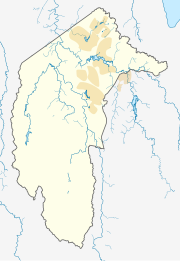
Summary
Gungahlin is a suburb in the Canberra, Australia district with the same name; Gungahlin. The postcode is 2912. Gungahlin is the name for the entire district, and also the town centre, but it is also the name of the suburb which Gungahlin Town Centre is in.
| Gungahlin Canberra, Australian Capital Territory | |||||||||||||||
|---|---|---|---|---|---|---|---|---|---|---|---|---|---|---|---|
 Hibberson Street in May 2020 | |||||||||||||||
 Gungahlin | |||||||||||||||
| Coordinates | 35°11′00″S 149°07′55″E / 35.18335°S 149.13185°E | ||||||||||||||
| Population | 8,586 (SAL 2021)[1] | ||||||||||||||
| Established | 1998 | ||||||||||||||
| Postcode(s) | 2912 | ||||||||||||||
| Elevation | 627 m (2,057 ft) | ||||||||||||||
| Area | 4.6 km2 (1.8 sq mi) | ||||||||||||||
| Location |
| ||||||||||||||
| District | Gungahlin | ||||||||||||||
| Territory electorate(s) | Yerrabi | ||||||||||||||
| Federal division(s) | Fenner | ||||||||||||||
| |||||||||||||||
It is next to the suburbs of Ngunnawal, Palmerston, Franklin, Harrison, Throsby, Forde and Amaroo. Burgmann Anglican School is located in the suburb. The edges of the suburb are on Horse Park Drive, Gundaroo Drive and Gungahlin Drive.
Gungahlin Town Centre edit
The commercial heart of the Gungahlin Town Centre is Hibberson St, the centre's main street, though the boundary of commercial activities in Anthony Rolfe Avenue, Gundaroo Drive and Gozzard Street. There are currently four retail anchor stores in the town centre, namely Coles, Woolworths, Aldi and Big W which are located in separate developments in Hibberson Street. There are two licensed clubs in the Town Centre: the Raiders Club located at the intersection of Hibberson and Gozzard Streets; and Eastlake Gungahlin Club located at the intersection of Hinder and Efkarpidis Streets. The Gungahlin Public Library officially opened in June 2011,[2] and adjoining senior high school opened later that year. Burgmann College is located in the suburb of Gungahlin.
Gungahlin Town Centre is one endpoint of stage 1 of Canberra's Light Rail network. Stage 1 runs from Gungahlin Town Centre to Civic.
Demographics edit
At the 2021 census, the population of Gungahlin was 8,586, an increase from 5,617 in 2011[3] and 3,857 in 2006,[4] including 153 (1.8%) Indigenous persons and 4,157 (48.4%) Australian-born persons. The next most common countries of birth were China (8.7%), India (7.5%), Nepal (4.9%), South Korea (3.0%) and Vietnam (1.9%). 48.5% of people spoke only English at home. Other languages spoken at home included Mandarin (9.8%), Nepali (4.7%), Korean (3.2%) and Vietnamese (2.2%). The most common responses for religion were No Religion (39.5%) and Catholic (14.4%). 35.5% of dwellings were separate houses, 17.4% were semi-detached, row or terrace houses or townhouses and 46.5% of were flats or apartments.[5]
Geology edit
The Gungahlin suburb is underlain by the middle Silurian age Canberra Formation. Most of this is slaty shale and mudstone. But there are also a couple of bands of ashstone in the south and north west. The structure of the rock has been folded by anticlines and a syncline with a north east direction. The Gungahlin Fault is parallel to the folds and passes through the east of the town centre. To the south it passes through Crace, Kaleen, Bruce and Aranda where it stops at the Deakin Fault. The Gungahlin Fault is also parallel to the Winslade Fault and is no doubt connected with it. In the north east direction it passes out of the ACT northern end and ends near the Sullivans Fault.[6]
Footnotes edit
- ^ Australian Bureau of Statistics (28 June 2022). "Gungahlin (suburb and locality)". Australian Census 2021 QuickStats. Retrieved 28 June 2022.
- ^ Corbell, Simon (17 June 2011). "Minister to officially open $13 million Gungahlin Public Library" (Press release). Archived from the original on 21 February 2014.
- ^ Australian Bureau of Statistics (31 October 2012). "Gungahlin". 2011 Census QuickStats. Retrieved 5 September 2022.
- ^ Australian Bureau of Statistics (25 October 2007). "Gungahlin". 2006 Census QuickStats. Retrieved 5 September 2022.
- ^ Australian Bureau of Statistics (28 June 2022). "Gungahlin". 2021 Census QuickStats. Retrieved 5 September 2022.
- ^ Henderson G A M and Matveev G, Geology of Canberra, Queanbeyan and Environs 1:50000 1980.


